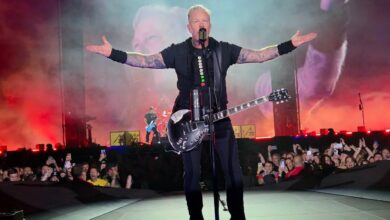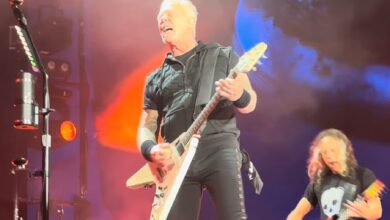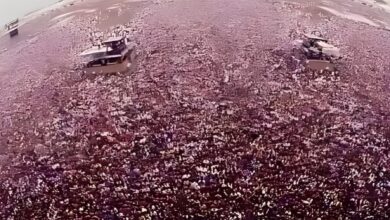Metallica Shook Adelaide to Its Core with a Bone-Crushing “Sad But True” at Adelaide Oval 2025
On a warm Wednesday night in early November, Adelaide Oval stopped feeling like a cricket ground and turned into a fortress of riffs. The M72 World Tour had finally rolled into South Australia, and the city treated it like a once-in-a-generation event. Long before Metallica walked on, black-clad fans flooded across the bridge, past the river and into the stadium, turning the precinct into a moving sea of band shirts, tattoos, and nervous excitement. Inside, the massive circular stage sat like a spaceship in the middle of the oval, ringed by towering video screens and a forest of lighting rigs. By the time the last rays of daylight faded, more than 45–50,000 people had taken their spots, ready to be blasted into orbit by four men who have been rewriting heavy metal history for over four decades.
The build-up was anything but quiet. Suicidal Tendencies hit first, injecting a dose of high-speed punk-thrash chaos that loosened up the early arrivals and sent circle pits spinning before the sun had even fully set. Evanescence followed with a dramatic, gothic-rock set that felt almost cinematic under the stadium lights, Amy Lee’s voice soaring across the stands and echoing off the grandstands. Their presence underscored how unusual this bill was: a cross-section of alternative and metal history warming up the crowd for the kings of the genre. Between sets, cameras panned across families, teenagers in fresh tour shirts, and veterans in faded Justice and Master of Puppets gear who had clearly seen all this before—and still looked like kids the night before Christmas.
Then came the moment every Metallica fan knows by heart: the lights dipping, the murmur turning into a roar, and Ennio Morricone’s “The Ecstasy of Gold” rolling over the PA. On the circular screens, the classic Sergio Leone footage played, while thousands sang along like it was already the first song of the night. When the band finally strode out to their positions and slammed into the opening barrage—Creeping Death, For Whom the Bell Tolls, Leper Messiah, and King Nothing—the stadium instantly shifted from anticipation to full-scale eruption. The sound was massive yet surprisingly clear, the riff of Creeping Death slicing through the night air while the entire lower bowl jumped in unison, proving Adelaide was not here to politely observe but to actively join in the carnage.
James Hetfield, grinning beneath the stadium lights, took a moment between songs to size up the crowd. “Adelaide! You’re alive!” he barked, as if he needed confirmation of what was already obvious. The response was deafening, a wall of noise that made him chuckle before he launched into his familiar pre-song routines—getting each side of the oval to out-shout the others, teasing the folks in the Snake Pit, and acknowledging the fans in the nosebleeds who had turned the farthest seats into their own private warzone. Lars Ulrich, from his drum throne in the center, looked like he was conducting controlled chaos, pointing drumsticks at different sections of the crowd as if picking teams for some giant, global headbanging contest.
As the set moved deeper into the night, the band shifted gears between eras—slamming out the punishing groove of Fuel, letting the darkness creep in with Fade to Black, and stretching the tension with The Day That Never Comes. Each song gave the crowd a different way to lose themselves, from furious moshing to closed-eyes sing-alongs. By the time the ominous intro that would lead to Sad But True began to rumble through the PA, the audience had already been taken on a tour of Metallica’s entire emotional range. The lighting dropped into a cold, industrial blue, smoke crept across the stage, and the opening drum hits felt less like a beat than the slow stamping of some enormous mechanical beast waking up beneath the oval.
Sad But True has always been one of Metallica’s heaviest live weapons, but in Adelaide it landed with a special kind of weight. Lars’s drums hit like piledrivers, each snare crack echoing across the stadium with almost disturbing clarity, while Robert Trujillo’s bass added a subsonic growl that you could feel in your chest and the concrete beneath your shoes. Kirk Hammett and James locked into that iconic drop-D riff, letting it breathe just a fraction slower than the studio version, the extra space making every note feel thicker and meaner. When James stepped up to the mic to deliver the first line—“Hey, I’m your life…”—it sounded less like a lyric and more like a threat, spat out with decades of experience behind it.
What made this particular rendition so addictive, and so perfect for the 4K fan footage that later surfaced online, was the way the entire stadium became part of the groove. On every “HEY!” accent in the verse, tens of thousands of fists punched the air in perfect time, a synchronized motion that rippled around the oval like a shockwave. In the inner ring, people were headbanging so hard their hair became a blur; higher up, fans who couldn’t move as freely still jerked their shoulders and stomped their feet, unable to resist the song’s gravitational pull. Even those who came mainly for the hits or the nostalgia seemed dragged into the moment, caught by a riff that’s simple on paper but devastating in execution.
Visually, Sad But True turned Adelaide Oval into its own dystopian movie set. The giant screens, which had been cycling through live close-ups all night, suddenly leaned into stark contrasts—tight shots of Hetfield’s grimacing face, the sweat flying off Lars’s arms, and Trujillo’s fingers attacking the strings. The lighting rig flooded the stadium with alternating blasts of blue and white, then cut back to darkness between hits, creating the illusion that each snare and kick was briefly turning the whole oval on and off. From the upper stands, the stage looked like a beating mechanical heart; from the rail, the song felt like being inside the engine room of a war machine. Even in the 4K clip, you can sense that scale: the camera barely sitting still as the person filming headbangs along, unable to stay purely in “videographer” mode.
Kirk Hammett’s solo during Sad But True is less about speed and more about attitude, and in Adelaide he leaned all the way into that swagger. Instead of racing through the notes, he bent them, smeared them, and let them hang in the air just a fraction longer. At a few key moments he turned toward James, the two of them squaring off like guitar-slinging gunslingers under the lights. Robert roamed the circular stage, locking eyes with fans in every direction, dropping into wide-legged stances that looked like they’d been pulled straight out of a classic metal photo shoot. Lars, meanwhile, peppered the groove with tiny rhythmic nudges and extra cymbal hits, proof that even after thousands of performances he’s still finding new ways to play the song without breaking its spine.
Part of what gives this performance its power is the history behind the song. Sad But True comes from the Black Album, the record that turned Metallica from underground thrash leaders into one of the biggest bands on the planet. It has been played well over a thousand times live and remains a staple in their setlists; on this tour, it’s one of the pillars that props up the entire night. Knowing that, there is something special about hearing it roar across an Australian stadium so many years after its release, the riff still fresh enough to make new fans and still heavy enough to satisfy those who have been shouting along since the early nineties. Adelaide’s rendition, now immortalized in crisp 4K video, feels like one more chapter in a story that began in 1991 and refuses to end.
When the last chorus crashed down and James hit the final “Sad but true!” the release in the stadium was physical. People clapped, shouted, and then immediately started chanting again, as if trying to drag out the moment. The band barely let it settle before pivoting into the next part of the set, using that surge of energy to power through more classics. Songs like Nothing Else Matters and Seek & Destroy gave the night its emotional and old-school thrash peaks, while newer tracks like Lux Æterna kept the show locked firmly in the present, reminding everyone that this is not some nostalgia act coasting on its past. It felt like Sad But True sat at the center of the night’s gravity, a midpoint blast that everything else orbited around.
Adelaide also got a uniquely local moment that deepened the sense of occasion. Later in the set, Metallica surprised the crowd by weaving in covers of Australian rock staples, including a swaggering take on INXS’s “Need You Tonight” and a nod to The Angels. Fans who grew up on Aussie pub rock suddenly heard their own musical heritage filtered through Metallica’s sound, creating a bridge between cultures that felt totally natural in the moment. The crowd’s reaction was immediate and loud; people who might have hesitated earlier were now singing along with a kind of patriotic pride, thrilled to hear their homegrown heroes honored on such a massive stage.
By the time the night began edging toward its finale, you could feel the collective exhaustion mixing with exhilaration. People leaned against railings, sweat-drenched and hoarse, but absolutely no one looked ready to leave. The final stretch of the show, with its run of monumental songs—One, Master of Puppets, and of course Enter Sandman—felt like a reward for surviving the earlier onslaught. In the context of that massive closing run, Sad But True stood out in memory as the moment where the show’s momentum shifted from simply “incredible concert” to “legendary night,” the point at which Adelaide Oval stopped being just another stop on a world tour and became its own story that fans would be telling for years.
What made the Adelaide rendition particularly fun to revisit through the 4K footage is the way it captured tiny, human details you might miss in the moment. You can see the security guards nodding their heads despite themselves, the strangers putting arms around each other’s shoulders, and the fans in the far seats whipping their phone flashlights into the air on the slower vocal lines. There is a kid on someone’s shoulders halfway back who knows every word, and an older fan near the rail mouthing along with a look that says he’s been waiting for this song since Metallica last played the city. The video doesn’t just document a performance—it documents a community forming in real time around a shared groove.
All of this took place under a production design that could easily have overshadowed the music, but never did. The M72 stage is deceptively simple: no elaborate props, just a circular platform, four towering mic positions, and screens that act as both magnifying glass and storytelling tool. In Adelaide, those screens showed close-ups of calloused fingers, sweat, and smiles, reminding everyone that for all the spectacle, this was still four musicians playing songs they wrote decades ago. The pyro, the strobes, and the towering arrays of speakers only added intensity to what was essentially a very direct transaction between band and audience. Sad But True, with its slow-motion stomp and wide sonic spaces, might have been the best showcase of that minimalist-but-massive approach.
Walking out of Adelaide Oval after the final bows, people moved slowly, partly because of the crowd and partly because no one quite wanted to break the spell. Conversations drifted above the shuffle of feet: debates about the best song of the night, praise for Lars’s stamina, amazement at the Australian covers, and constant references to “that groove” during Sad But True. Many were already pulling up early uploads of the 4K clip on their phones, showing friends who’d been too far away or too caught up in the moment to film. For those who were there, the video is a souvenir; for those watching from elsewhere, it’s proof that on November 5, 2025, Metallica turned Adelaide into a living, breathing amplifier. It was not just another great performance of a classic song—it was the moment the entire city seemed to move in time with one unstoppable riff.





